Initially captured by the Spanish during the age of colonization, the name Florida comes from La Florida, meaning “the flower.”
Due to its prevalent tropical and sub-tropical climates, Florida has a unique array of fauna and flora—meaning lots of bird species. In fact, Florida contains around 400 bird species!
Of the 17 hummingbird species found across the States, only three species are residents of Florida.
There have, however, been some rare visits from other species.
Florida Hummingbirds, Facts, And Examples
Although there are only three species of hummingbird regularly found in Florida, there have been rare sightings of rare species.
Resident Hummingbirds Of Florida
Florida is home to only one species of hummingbird that stays throughout the year.
Ruby-throated Hummingbird (Archilochus colubris)

- Length: 8 – 3.5 inches
- Weight: 1 – 0.2 oz
- Wingspan: 1 – 4.3 inches
Description:
These hummingbirds have an emerald or golden-green back and crown and their underparts are grey to white.
Their common name is attributed to males also having a bright red throat, while female Ruby-throated hummingbirds do not.
Additional Information:
Their diet consists of nectar (cardinal flower, bee-balm, honeysuckle, jewelweed, red buckeye, red morning glory, and trumpet creeper). They also eat small insects.
They are distributed from central Kansas to the east coast and Saskatchewan to central Florida in natural areas (grasslands and forest edges) and man-altered regions (gardens and parks).
These common hummingbirds often aggressively defend their food sources—like hummingbird feeders—from other hummingbirds.
They skit around, followed by immediate stopping and hovering when they have found a good food source.
Many individuals will migrate to Mexico and Central America during winter, but some remain in North America’s Southern Florida.
Hummingbirds Found Seasonally in Florida
The following two hummingbird species are frequently found in Florida, but only at certain times of the year, migrating away and returning.
Black-chinned Hummingbird (Archilochus alexandri)

- Length: 5 inches
- Weight: 1 – 0.2 oz
- Wingspan: 3 inches
Description:
These hummingbirds have a metallic green head, flanks, back, a grey-white underside, and a black bill.
The Black-chinned hummingbird’s name is derived from the male’s black throat, which has a thin line of purple at the bottom. Females, however, lack this. They do, however, have white tips on three of their tail feathers.
Additional Information:
Black-chinned hummingbirds are generally located along the western side of the USA during the summer months, and their diet primarily consists of nectar and the occasional tiny insect.
Black-chinned hummingbirds are often found along canyons and rivers or around tall trees in various habitats, from lowland deserts to mountainous forests. They are also found in built-up areas of human occupancy.
Males will perch on high to watch for food and competition. These cheeky birds are quick to chase said competitors away.
During the winter months, Black-chinned hummingbirds head towards Central America and the Gulf of Mexico. Some, however, winter in southern Florida, or at least visit during the fall.
Rufous Hummingbird (Selasphorus rufus)

- Length: 8 – 3.5 inches
- Weight: 1 – 0.2 oz
- Wingspan: 3 inches
Description:
Rufous hummingbirds are so named because males have a bright orange back and belly, with a striking red throat.
Females have rufous flanks and rufous patches on their green tails. They have green heads and backs and sometimes an orange throat spot.
Additional Information:
Rufous hummingbirds eat nectar from columbine, scarlet gilia, mints, lilies, and heaths, to name a few. They also eat small insects caught on the wing or retrieved from spider webs.
Rufous hummingbirds are located along the western parts of the USA, all the way to Alaska in the north, in various habitats (forest clearings, forests, and meadows). They are found between sea level and 6,000 feet.
These hummingbirds are renowned for their aggressive behavior, often chasing larger hummingbird species away from feeders and flowers.
Rufous hummingbirds migrate to Mexico, where they spend the winter in higher elevation shrubby areas and oak/pine forests (7,500 to 10,000 feet). Individuals will also winter in Florida.
Hummingbirds That Are Seen (On Rare Occasions) in Florida
We’ve looked at those frequently found species in Florida (whether they are residents or spend a season there).
Briefly, we will examine some of the species which might, on rare occasions, find themselves in Florida.
Allen’s Hummingbird (Selasphorus sasin)
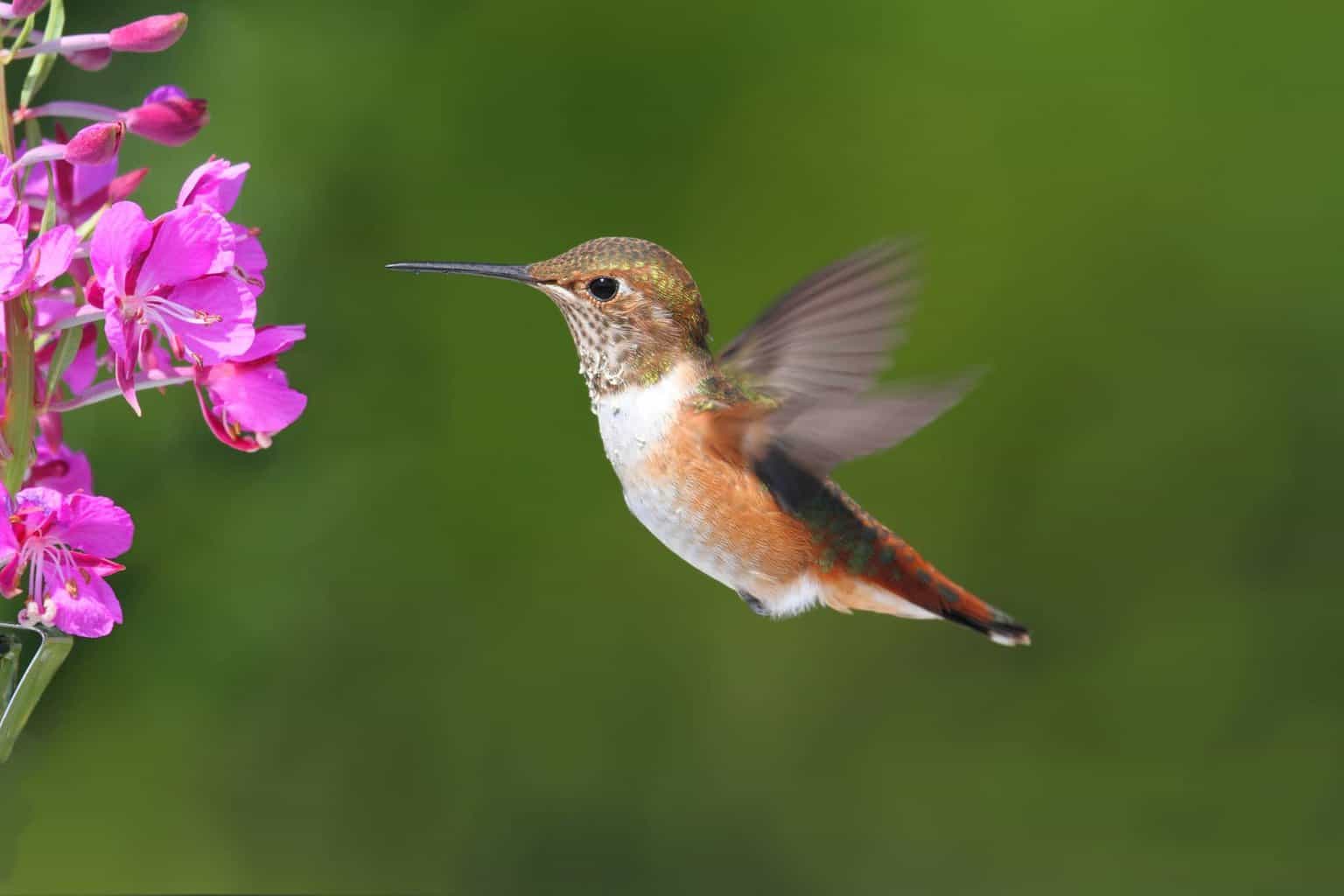
- Length: 5 inches
- Weight: 1 oz
- Wingspan: 3 in
Description:
These hummingbirds are green and orange. Males have a copper belly, eye marking, tail, a bronze-green back, and a red-orange throat.
Females are the same bronze-green, with lighter sides and bronze spots, and a small red-orange area on their throats.
Additional Information:
These hummingbirds are generally found along North America’s coastal Oregon and California when not migrating.
Canyons, coastal forests, city parks, open oak woods, scrub, and suburbs with lots of trees are typical habitats that Allen’s hummingbirds select.
Allen’s hummingbirds head south towards Mexico during migrations.
Allen’s hummingbirds’ diets consist of insects, including ants, flies, small beetles, and nectar.
Anna’s Hummingbird (Calypte anna)
- Length: 9 inches
- Weight: 1 – 0.2 oz
- Wingspan: 7 inches
Description:
These hummingbirds have occasional orange or rufous markings on green and grey bodies.
Males have red-pink feathers on their heads and throats, while females do not.
Additional Information:
These, primarily non-migratory, birds are distributed along the west coast, from California to Canada. Their interior range extends to western Arizona.
They are found in chaparral, city parks, gardens, coastal scrub, open woods, and savannas.
During migrations, Anna’s hummingbirds move from lower elevations during the winter to higher elevations in the summer.
Anna’s hummingbirds’ diets consist of nectar from Manzanita, currant, and gooseberry plants. They, however, also eat insects, including leafhoppers, midges, and whiteflies.
Antillean Crested Hummingbird (Orthorhyncus cristatus)

- Length: 5 inches
- Weight: 14 oz
- Wingspan: 5 inches
Description:
These hummingbirds have a combination of green, blue and purple on a dark background, which is found on the birds’ heads, back, sides, and wings.
Males are black underneath, while females are paler. This species is named for its head crests.
Additional Information:
These hummingbirds are located mainly along the British Virgin Islands and may move to the mainland on infrequent occasions.
Antillean crested hummingbirds prefer subtropical or tropical moist lowland forests. They also inhabit semiarid forest parks and plantations at altitudes from sea level to mountain slopes.
Their diet constitutes nectar (including Euphorbia and Lantana) and arthropods (insects and spiders).
Bahama Woodstar Hummingbird (Callephlox evelynae)

- Length: 1 – 3.7 inches
- Weight: 5 – 1.06 oz
- Wingspan: 5 inches
Description:
Males have backs that are green and gold, with white flanks and an olive underside. They also have a bright purple throat with a white stripe and a black-purple tail.
Females are also green and gold, but they do not have purple throats. Their flanks are a cinnamon color.
Additional Information:
These hummingbirds are generally found around the Bahamian Archipelago and are more frequent, rare visitors to Florida.
Bahama Woodstars Hummingbirds occupy various habitats, including lowland scrub, tropical evergreen, pine forest edges, and gardens.
These aggressive birds don’t tolerate other Woodstars well, often fighting.
They are considered year-round species and don’t often migrate; however, these hummingbirds have been spotted as far north as Pennsylvania.
Blue-throated Mountain-gem Hummingbird (Lampornis clemenciae)
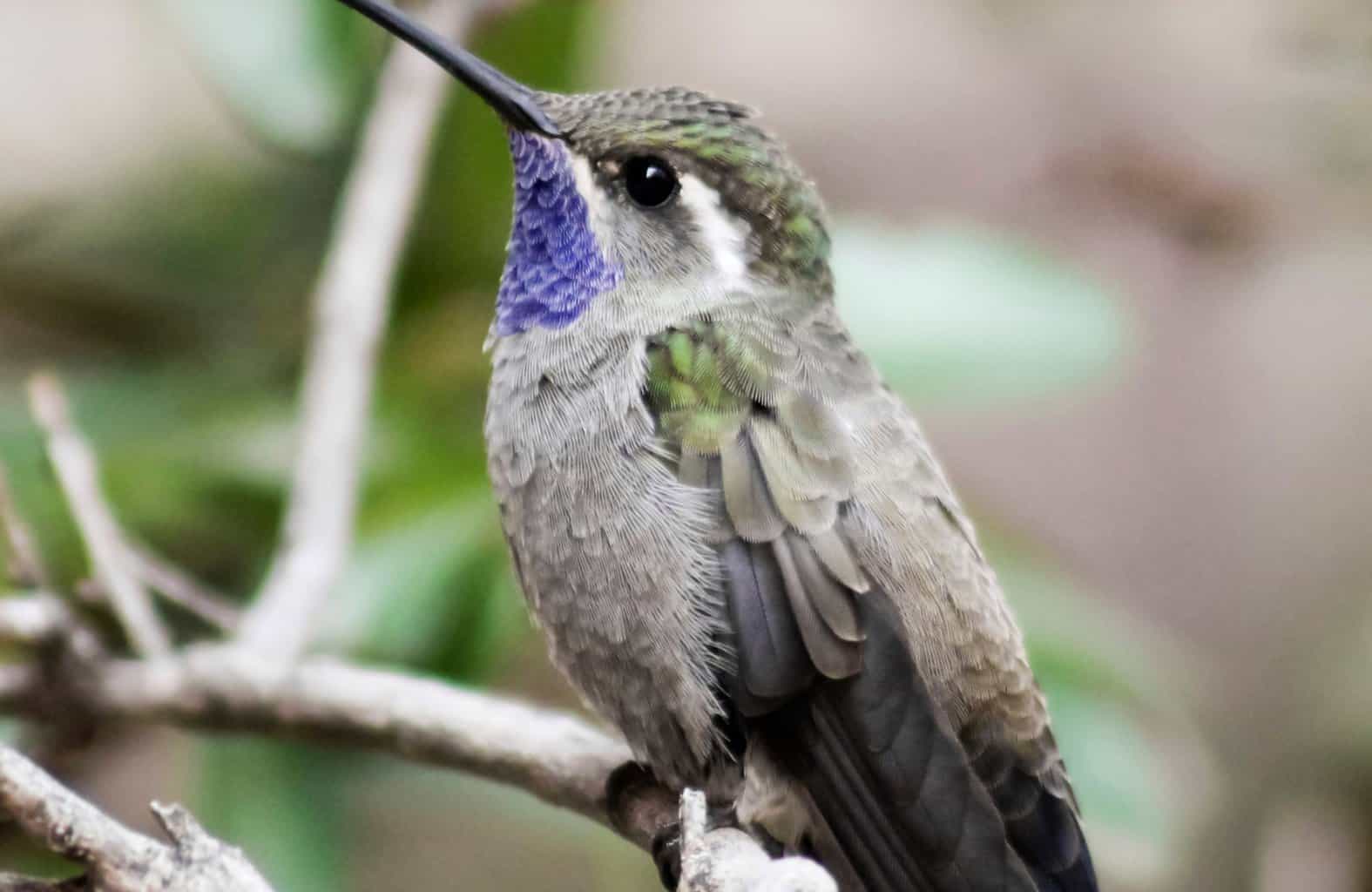
- Length: 3 – 4.7 inches
- Weight: 3 oz
Description:
Both males and female Blue-throated Mountain-gem hummingbirds have a bronze-green back, with white lines surrounding the eyes.
Blue-throated hummingbird males, like their name, also have a blue throat.
Blue-throated Mountain-gem hummingbirds’ underneath is grey, with white tips. Females, however, do not have blue throats.
Additional Information:
These hummingbirds are generally located in canyons in select mountains north of Mexico in Central America (when not within their Mexican distribution).
Blue-throated mountain-gem hummingbirds inhabit coniferous forests, pine-oak woods, and streamside sycamores.
These Blue-throated hummingbirds’ diet consists of nectar and insects. Due to their large size, they are often aggressive towards other hummingbird species.
These birds migrate back down to Mexico during the fall.
Broad-billed Hummingbird (Cynanthus latirostris)

- Length: 2 – 4 inches
- Weight: 1 oz
- Wingspan: 5 inches
Description:
Males have a blue throat and black-tipped red bill, with a green body. Females have grey undersides, a gold-green back, and head, and a white line from the eye moving backward.
Additional Information:
These birds are distributed through Mexico and canyons of mountainous parts of southwestern USA during the breeding season.
Broad-billed hummingbirds inhabit canyons and mountain meadows up to 9,800 feet. They also occur in lowland thorn forests and tropical deciduous forests in their Mexican winter grounds.
Their diet consists of nectar from tubular flowers (Arizona sycamore, Fremont cottonwood, and desert willow) and insects.
Broad-tailed Hummingbird (Selasphorus platycercus)
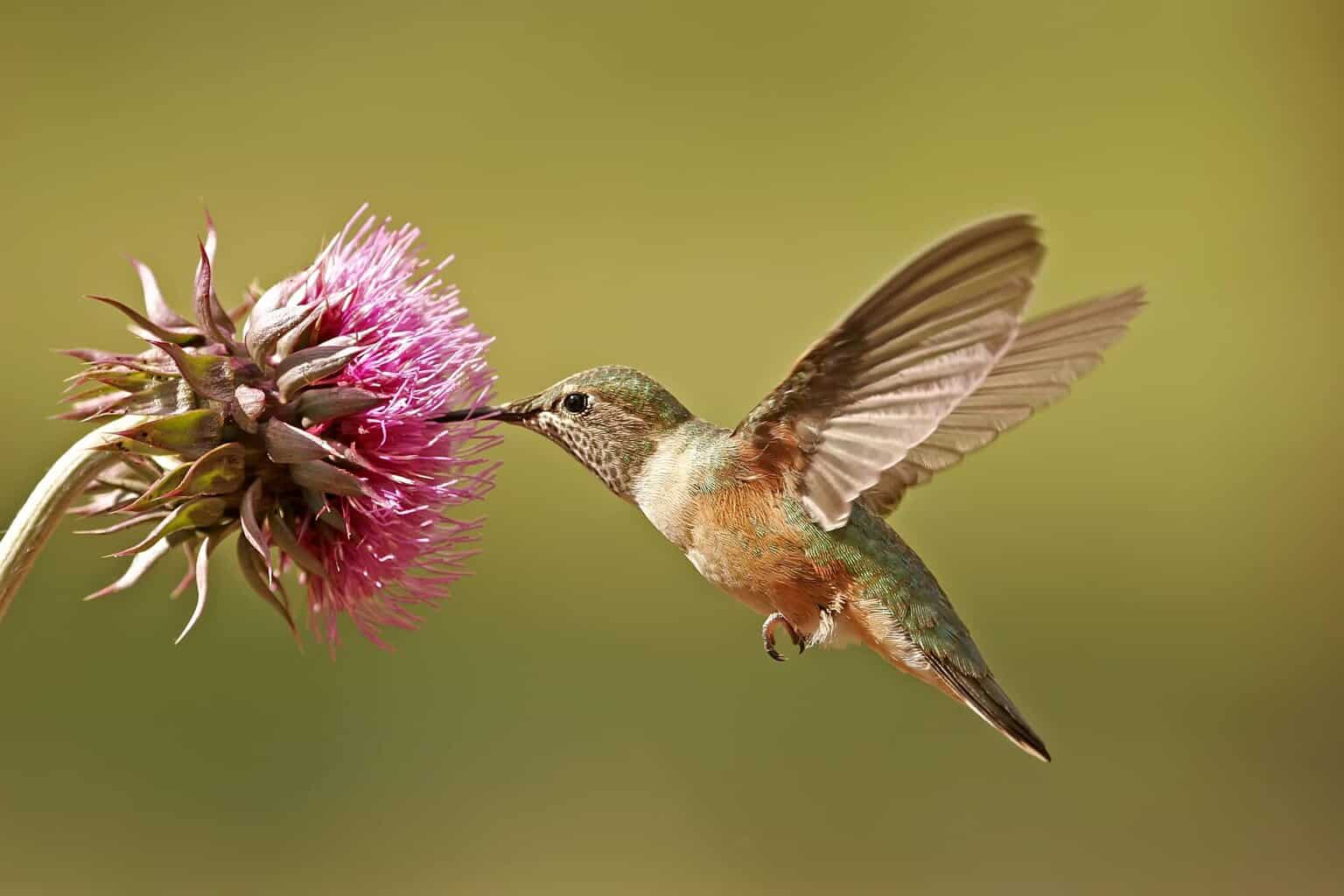
- Length: 1 – 3.5 inches
- Weight: 1 – 0.2 oz
- Wingspan: 25 inches
Description:
Broad-tailed hummingbirds have a white chest extending down the belly as a line, green or buff flanks, and green on their backs and heads.
Male broad-tailed hummingbirds have magenta throat feathers, while females have green spots on their throats. Females also have white-tipped tail feathers.
Additional information:
These hummingbirds are distributed through the western USA and western Canada during the summer breeding season—through late summer.
Their diet consists of nectar from favorite flowers and insects, and they are located primarily in meadows and open woodlands.
Buff-bellied Hummingbird (Amazilia yucatanensis)
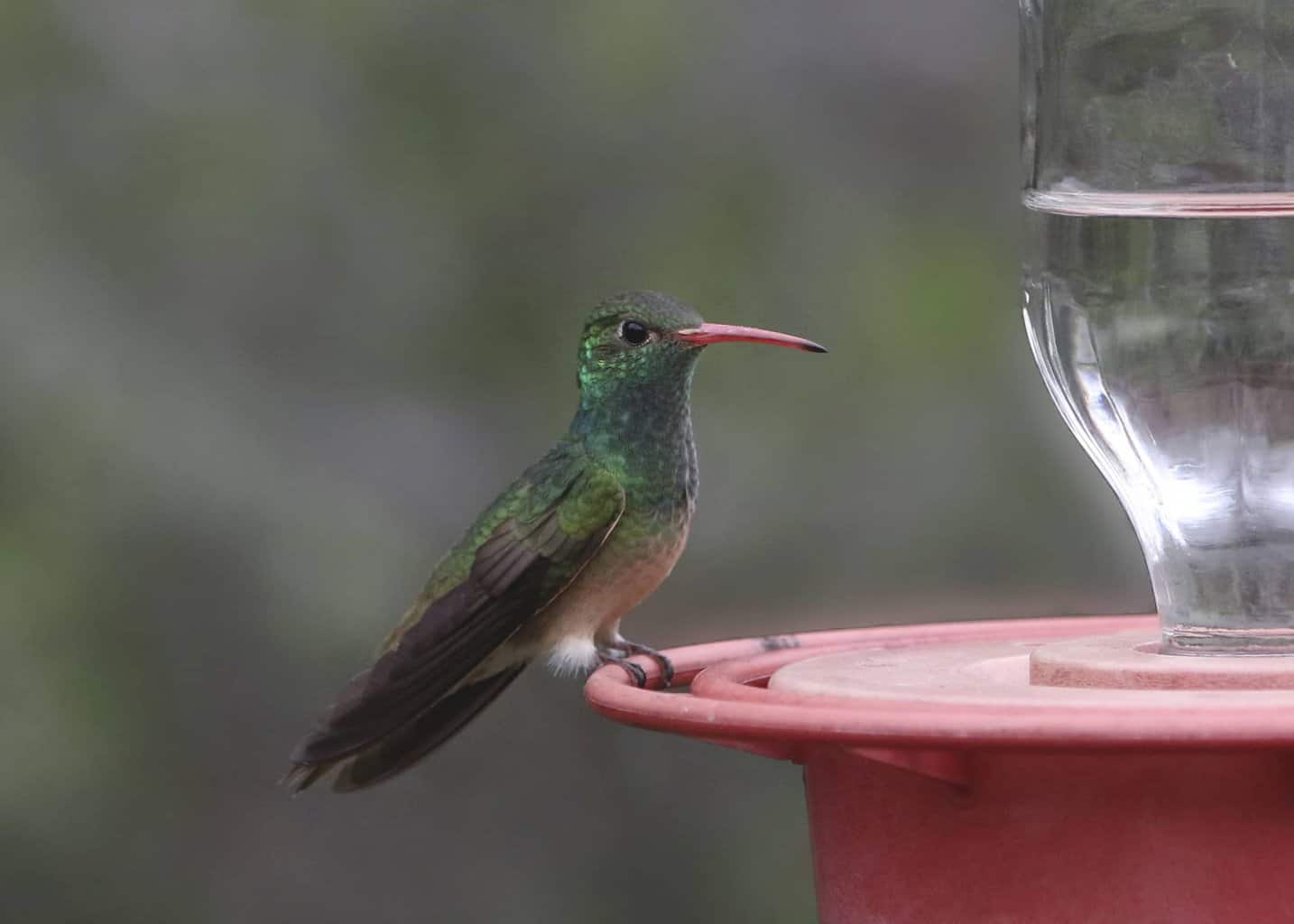
- Length: 9 – 4.3 inches
- Weight: 1 oz
- Wingspan: 9 – 4.3 inches
Description:
Both male and female Buff-bellied hummingbirds have a back and head of bronze-green, a buff belly, and a blue-green throat and breast.
Buff-bellied hummingbirds also have a black-tipped red bill with a rufous tail.
Additional Information:
These hummingbirds are found in the southernmost reaches of Texas during the breeding season. Some migration occurs north of Louisiana.
They inhabit scrub and wooded areas, where they eat nectar and insects.
Calliope Hummingbird (Selasphorus calliope)

- Length: 1 – 3.5 inches
- Weight: 1 oz
- Wingspan: 1 – 4.3 inches
Description:
Calliope hummingbirds have heads and backs that are green. Males have magenta lines on their throats and green chests, while females have a peach hue underneath.
Additional Information:
During the summer, Calliope hummingbirds are found between British Columbia and California. They, however, migrate to Mexico, Central America, and the southwestern United States.
Their diet consists of nectar and insects found in various habitats, from deserts to mountain forest edges.
Costa’s Hummingbird (Calypte costae)
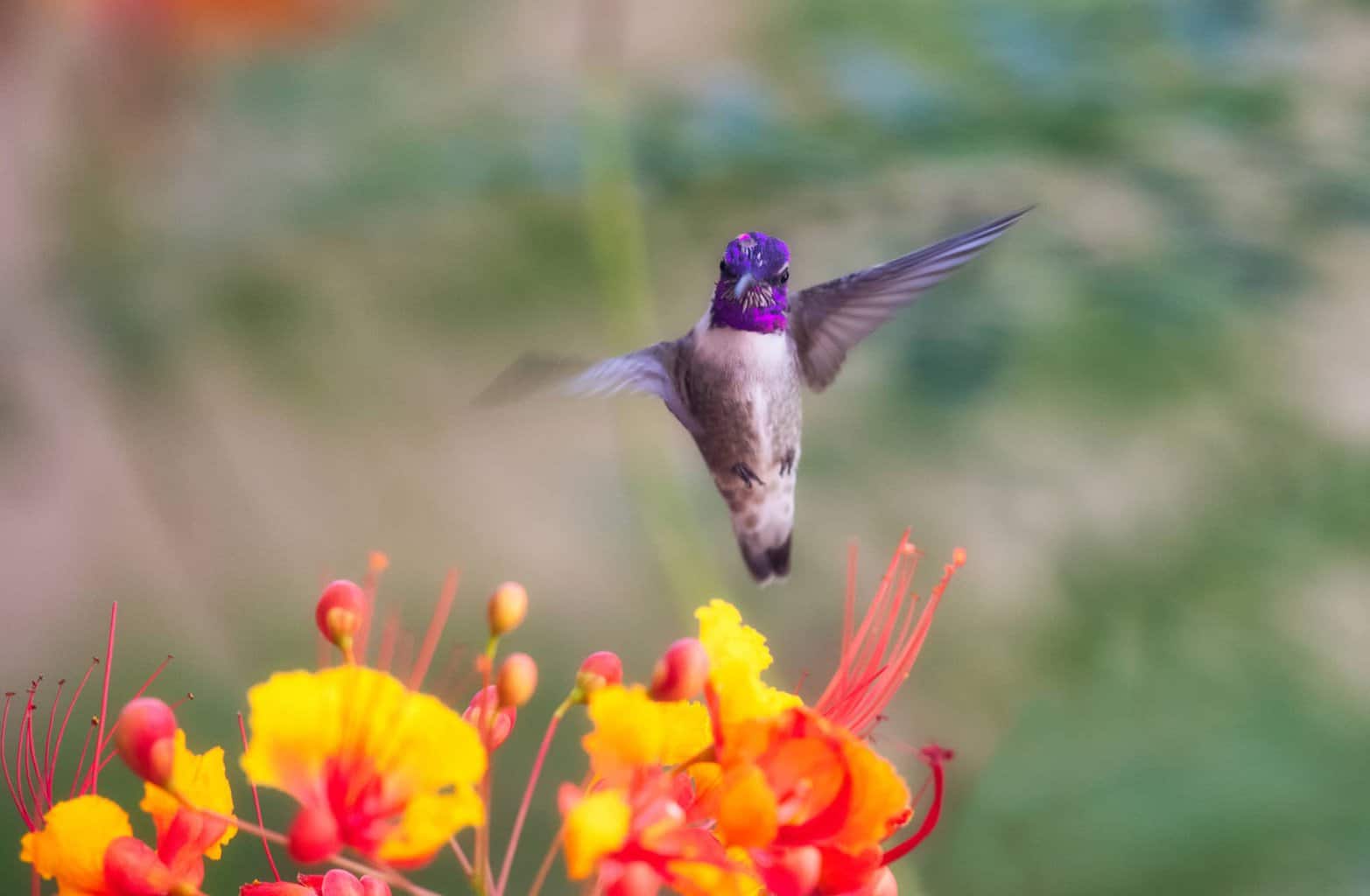
- Length: 5 inches
- Weight: 1 oz
- Wingspan: 3 inches
Description:
Females have light green heads and backs, with white underneath and an eyebrow stripe.
Males have a greenback and chest piece with a purple crown and throat.
Additional Information:
Generally found in the southwest of the USA, this hummingbird population has ventured to British Columbia, Alaska, and Canada.
They inhabit a range of habitats, from desert scrub to deciduous forests, where they eat nectar and insects.
Green-breasted Mango Hummingbird (Anthracothorax prevostii)
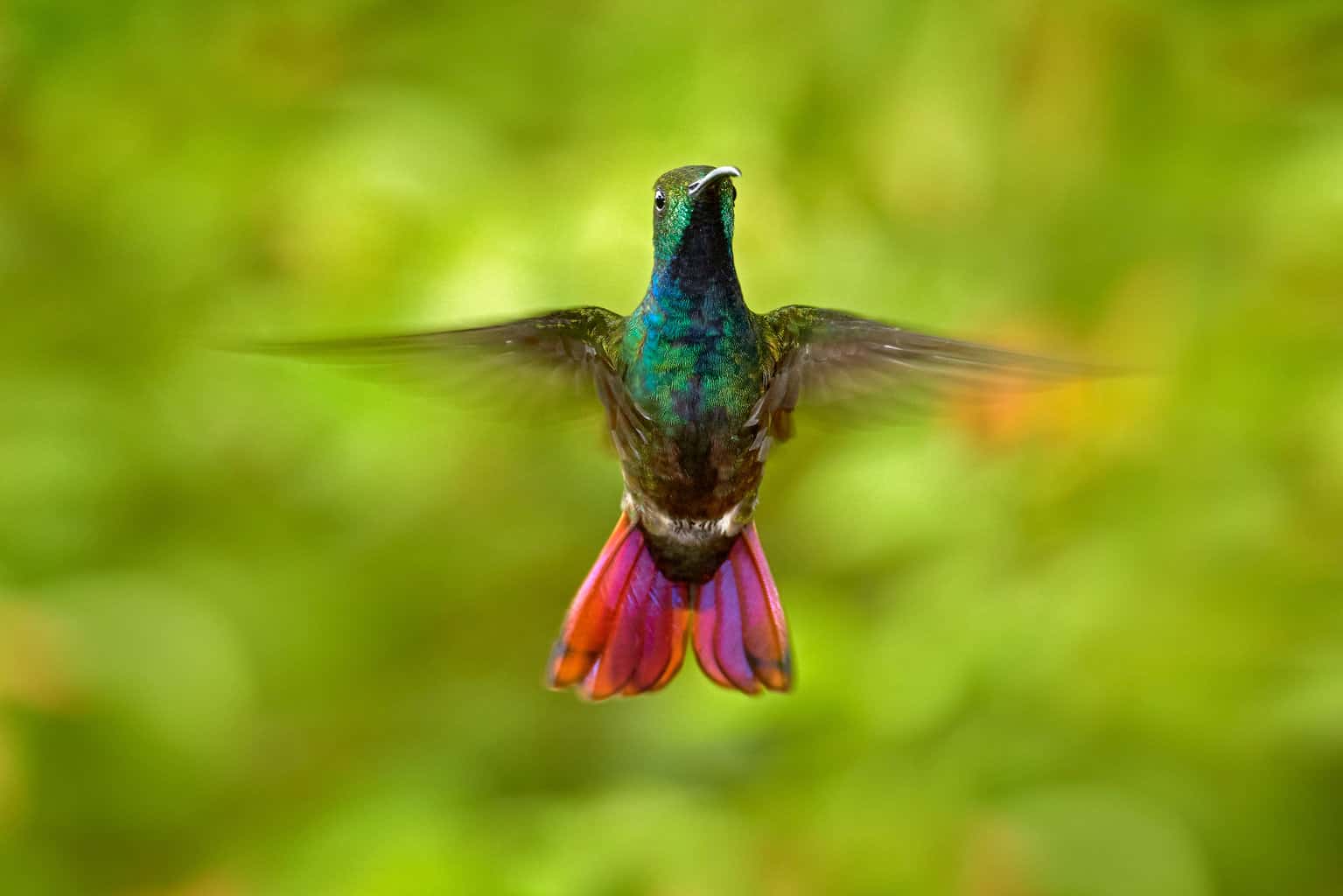
- Length: 3 – 4.7 inches
- Weight: 2 – 0.3 oz
- Wingspan: 25 inches
Description:
They have an overall green color, yellow-brown flanks, and a blue throat and chest. Their tails can have glimmers of color—in orange-red, magenta, or purple.
Females have magenta bands and white tips in their tails as well. Males have more striking green backs and heads, a matte black spot on their throat, and green flanks.
Additional Information:
These tropical hummingbirds are found from Mexico to Panama and some areas of Costa Rica. Younger birds have, however, made an appearance in southern and coastal Texas.
Their diet consists of nectar from favorite flowers and insects, and they are found in semi-open wooded habitats.
Magnificent (Rivoli’s) Hummingbirds (Eugenes fulgens)

- Length: 3 – 5.5 inches
- Weight: 3 oz
- Wingspan: 1 inch
Description:
Males have a green back and head, with a dark belly and tail. They have purple crowns and green throats.
Females have green backs, grey bellies, and some lighter tips on their tails.
A small white post-eye mark is found in both species.
Additional Information:
These hummingbirds have a range from the southwestern USA down to western Panama. They are primarily found in mountainous areas.
Their diet consists of nectar and insects.
Mexican-violetear Hummingbird (Colibri thalassinus)

- Length: 8 – 4.7 inches
- Weight: 17 – 0.20 oz
- Wingspan: 7 inches
Description:
These hummingbirds have a violet ear spot on their necks. Their backs, throats, and chests are green, and so is their belly.
They have dark tails that are blue-green.
Additional Information:
Although these birds generally range from Mexico south to the north of South America, there have been birds as far north as the eastern USA and Canada.
They are found primarily in forested areas, where they eat nectar and insects and create breeding pairs.
White-eared Hummingbird (Basilinna leucotis)

- Length: 5 – 3.9 inches
- Weight: 1 oz
- Wingspan: 4 – 5 inches
Description:
Male and female White-eared hummingbirds are primarily green on their backs, heads, and breasts. Both sexes also have a white eye line.
They have black-tipped red bills. Males have a turquoise-green throat and violet and black crown and face—with iridescent feathers.
Additional Information:
These hummingbirds have a range from southern Mexico to Texas during the breeding season.
Their breeding habitats are found in pine-oak forests.
Conclusion
Although hummingbirds are restricted to the Americas, only around 17 species are commonly found in the USA. Of these 17, only three species of hummingbird are frequently found in Florida.
The other 14 in our list are incredibly unlikely to be seen more than once a decade in Florida.
That is to say, if climate change continues the way that it is, we should expect to see some drastic shifts in the distribution ranges of many species of birds and other animals.


